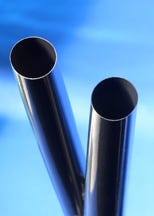Pipe and profile: Putnam pushes urethane tubing
Minimally invasive devices continue to test the limits of medical polymer tubing, and Putnam Plastics Co. (Dayville, CT) says it has responded with a technology to create thin-walled, large-diameter, low-durometer urethane extrusions. The minimally invasive movement in surgery is forcing device engineers to fit a greater amount of technology through a smaller working channel.
October 5, 2009
Minimally invasive devices continue to test the limits of medical polymer tubing, and Putnam Plastics Co. (Dayville, CT) says it has responded with a technology to create thin-walled, large-diameter, low-durometer urethane extrusions. The minimally invasive movement in surgery is forcing device engineers to fit a greater amount of technology through a smaller working channel. Byron Flagg, product manager extrusion and finishing at Putnam, says while the operational requirements of the tubing are a natural fit for thermoplastic urethane, the material poses some extrusion challenges. Flagg notes that as diameters increase and wall thickness and durometer decrease, the extrusion process can become unstable. That instability can result in a wider tolerance range and lower yield rates, leading device developers to compromise their designs. In addition to challenges during manufacture, in post-fabrication such extrusions can be difficult to handle without contamination or damage.
|
While he can’t offer specific details on the proprietary process Putnam has employed to overcome these challenges, Flagg did tell MPW that the trade secrets involved begin with the custom extrusion tooling and continue with downstream equipment and processes that “enhance and preserve the dimensional integrity of the extrusions.” Flagg says the process is compatible with standard medical-grade thermoplastic resins such as Lubrizol’s TecoFlex or Dow’s Pellethane, and that it utilizes a single-screw extruder.
The company says greater process stability results in a larger design envelope, while improved material handling reduces costs by increasing yields and product quality. Putnam offers the example of an 80 Shore A durometer urethane extrusion with a diameter greater than 0.5 inch (12.7 mm). The company says that if the minimum, feasible wall thickness had previously been 0.015 inch (0.38 mm), it can now be reduced to 0.003 inch (0.08 mm). Likewise, if the outer-dimension (OD) tolerance had previously been ±0.010 inch (0.25 mm), it can now be trimmed to ±0.002 inch (0.05 mm).
The company says that while the new capability is applicable across a range of custom extrusion designs, the greatest impact can be seen in tubes with ODs greater than 0.500 inch and wall thicknesses of less than 0.015 inch, with urethane durometers lower than 90 Shore A.
Earlier this year, MPW highlighted a Putnam technology dubbed Total Intermittent Extrusion (TIE). The company says this proprietary technology differs from this latest advance, and instead allows tubing to be extruded with variable durometers along the length. When they spoke with MPW, Putman officials did say they were currently working on a next-generation TIE technology. —Tony Deligio
About the Author(s)
You May Also Like



